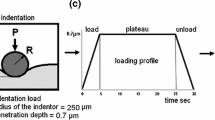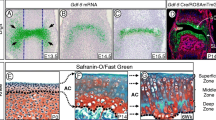Abstract
The mechanical behavior of cartilage is intimately related to its biochemical composition, and tissue composition is known to be influenced by its local mechanical loading environment. Although this phenomenon has been well-studied in adult cartilage, few investigations have examined such structure–function relationships in embryonic cartilage. The goal of this work was to elucidate the role of mechanical loading on the development of cartilage composition during embryogenesis. Using an embryonic chick model, cartilage from the tibiofemoral joints of immobilized embryos was compared to that of controls. The normal time course of changes in glycosaminoglycan/DNA and hydroxyproline/DNA were significantly influenced by loading history, with the most pronounced effects observed between days 9 and 14 during the period of most rapid increase in motility in control embryos. Stress-relaxation tests conducted on samples from day 14 indicate that the effects of embryonic immobilization on cartilage matrix composition have direct consequences for the mechanical behavior of the tissue, resulting in compromised material properties (e.g. 50% reduction in E inst). Because embryogenesis provides a unique model for identifying key factors which influence the establishment of functional biomechanical tissues in the skeleton, these data suggest that treating mechanical loading as an in vitro culture variable for tissue engineering approaches to cartilage repair is likely to be a sound approach.
Similar content being viewed by others
References
1Brown, T. D., and R. J. Singerman. Experimental determination of the linear biphasic constitutive coefficients of human fetal proximal femoral chondroepiphysis. J. Biomech. 19:597-605, 1986.
2Burton-Wurster, N., M. Vernier-Singer, T. Farquhar, and G. Lust. Effect of compressive loading and unloading on synthesis of total protein, proteoglycan, and fibronectin by canine cartilage explants. J. Orthop. Res. 11:717-729, 1993.
3Buschmann, M. D., Y. A. Gluzband, A. J. Grodzinsky, and E. B. Hunziker. Mechanical compression modulates matrix biosynthesis in chondrocyte/agarose culture. J. Cell Sci. 108:1497-1508, 1995.
4Copray, J. C. V. M., H. W. B. Jansen, and H. S. Duterloo. Effects of compressive forces on proliferation and matrix synthesis in mandibular condylar cartilage of the rat in vitro. Arch. Oral Biol. 30:299-304, 1985.
5Creemers, L. B., D. C. Jansen, A. van Veen Reurings, T. van den Bos, and V. Everts. Microassay for the assessment of low levels of Hydroxyproline. Biotechniques 22:656-658, 1997.
6Davisson, T., S. Kunig, A. Chen, R. Sah, and A. Ratcliffe. Static and dynamic compression modulate matrix metabolism in tissue engineered cartilage. J. Orthop. Res. 20:842-848, 2002.
7Demarteau, O., M. Jakob, D. Schafer, M. Heberer, and I. Martin. Development and validation of a bioreactor for physical stimulation of engineered cartilage. Biorheology 40:331-336, 2003.
8Farndale, R. W., D. J. Buttle, and A. J. Barrett. Improved quantitation and discrimination of sulphated glycosaminoglycans by use of dimethylmethylene blue. Bioch. Biophys. Acta 883:173-177, 1986.
9Germiller, J. A., and S. A. Goldstein. Structure and function of the embryonic growth plate in the absence of functioning skeletal muscle. J. Orthop. Res. 15:362-370, 1997.
10Gray, M. L., A. M. Pizzanelli, A. J. Grodzinsky, and R. C. Lee. Mechanical and physicochemical determinants of the chondrocyte biosynthetic response. J. Orthop. Res. 6:777-792, 1988.
11Guilak, F., D. L. Butler, and S. A. Goldstein. Functional tissue engineering: The role of biomechanics in articular cartilage repair. Clin. Orthop. 391(Suppl):S295-S305, 2001.
12Guilak, F., B. C. Meyer, A. Ratcliffe, and V. C. Mow. The effects of matrix compression on proteoglycan metabolism in articular cartilage explants. Osteoarthritis Cartilage 2:91-101, 1994.
13Hamburger, V., and M. Balaban. Observations and experiments of spontaneous rhythmical behavior in the chick embryo. Dev. Biol. 7:533-545, 1968.
14Hamburger, V., M. Balaban, R. Oppenheim, and E. Wenger. Periodic motility of normal and spinal chick embryos between 8 and 17 days of incubation. J. Exp. Zool. 159:1-14, 1965.
15Jones, I. L., D. D. S. Klamfeldt, and T. Sandstrom. The effect of continuous mechanical pressure upon the turnover of articular cartilage proteoglycans in vitro. Clin. Orthop. 165:283-289, 1982.
16Kim, Y. J., R. L. Sah, J. Y. Doong, and A. J. Grodzinsky. Fluorometric assay of DNA in cartilage explants using Hoechst 33258. Anal. Biochem. 174:168-176, 1988.
17Kim, Y. J., R. L. Y. Sah, A. J. Grodzinsky, A. H. K. Plaas, and J. D. Sandy. Mechanical regulation of cartilage biosynthetic behavior: Physical stimuli. Arch. Biochem. Biophys. 311:1-12, 1994.
18Korver, T. H., R. J. van der Stadt, E. Kiljan, G. P. J. Kampen, and J. K. van der Korst. Effects of loading on the synthesis of proteoglycans in different layers of anatomically intact articular cartilage in vitro. J. Rheumatol. 19:905-912, 1992.
19Larsson, T., R. M. Aspden, and D. Heinegard. Effects of mechanical load on cartilage matrix biosynthesis in vitro. Matrix 11:388-394, 1991.
20Li, K. W., A. K. Williamson, A. S. Wang, and R. L. Sah. Growth responses of cartilage to static and dynamic compression. Clin. Orthop. 391(Suppl):S34-S48, 2001.
21Llusa-Perez, M., S. Suso-Vergara, and D. Ruano-Gil. Recording of chick embryo movements and their correlation with joint development. Acta Anat. 132:55-58, 1988.
22Mauck, R. L., S. L. Seyhan, G. A. Ateshian, and C. T. Hung. Influence of cell seeding density and dynamic deformational loading on the developing structure/function relationships of chondrocyte-seeded agarose hydrogels. Ann. Biomed. Eng. 30:1046-1056, 2002.
23Mauck, R. L., M. A. Soltz, C. C. Wang, D. D. Wong, P. H. Chao, W. B. Valhmu, C. T. Hung, and G. A. Ateshian. Functional tissue engineering of articular cartilage through dynamic loading of chondrocyte-seeded agarose gels. J. Biomech. Eng. 122:252-260, 2000.
24Mikic, B., M. Wong, M. Chiquet, and E. B. Hunziker. Mechanical modulation of tenascin-c and collagen XII expression during avian synovial joint formation. J. Orthop. Res. 18:406-415, 2000.
25Mitrovic, D. Development of the articular cavity in paralyzed chick embryos and in chick embryo limb buds cultured in chorioallantoic membranes. Acta Anat. 113:313-324, 1982.
26Mow, V. C., S. C. Kuei, W. M. Lai, and C. G. Armstrong. Biphasic creep and stress relaxation of articular cartilage in compression: Theory and experiment. J. Biomech. Eng. 102:73-84, 1980.
27Mow, V., and M. Rosenwasser. Articular cartilage: Biomechanics. In: Injury and Repair of the Musculoskeletal Soft Tissues, edited by S. L. Y. Woo and J. A. Buckwalter. Illinois: American Academy of Orthopaedic Surgeons, 1988, pp. 427-463.
28Palmoski, M. J., and K. D. Brandt. Effects of static and cyclic compressive loading on articular cartilage plugs in vitro. Arthritis Rheum. 27:675-681, 1984.
29Parkkinen, J. J., M. J. Lammi, H. J. Helminen, and M. Tammi. Local stimulation of proteoglycan synthesis in articular cartilage explants by dynamic compression in vitro. J. Orthop. Res. 10:610-620, 1992.
30Sah, R. L., Y. J. Kim, J. H. Doong, A. J. Grodzinsky, A. H. K. Plaas, and J. D. Sandy. Biosynthetic response of cartilage explants to dynamic compression. J. Orthop. Res. 7:619-636, 1989.
31Saris, D. B., A. Sanyal, K. N. An, J. S. Fitzsimmons, and S. W. O'Driscoll. Periosteum responds to dynamic fluid pressure by proliferating in vitro. J. Orthop. Res. 17:668-677, 1999.
32Schneiderman, R., D. Kevet, and A. Maroudas. Effects of mechanical and osmotic pressure on the rate of glycosaminoglycan synthesis in the human adult femoral head cartilage: An in vitro study. J. Orthop. Res. 4:393-408, 1986.
33Stocum, D. L., R. M. Davis, M. Leger, and H. E. Conrad. Development of the tibiotarsus in the chick embryo: Biosynthetic activities of histologically distinct regions. J. Embryol. Exp. Morphol. 54:155-170, 1979.
34Williamson, A. K., A. C. Chen, and R. L. Sah. Compressive properties and function–composition relationships of developing bovine articular cartilage. J. Orthop. Res. 19:1113-1121, 2001.
Author information
Authors and Affiliations
Rights and permissions
About this article
Cite this article
Mikic, B., Isenstein, A.L. & Chhabra, A. Mechanical Modulation of Cartilage Structure and Function During Embryogenesis in the Chick. Annals of Biomedical Engineering 32, 18–25 (2004). https://doi.org/10.1023/B:ABME.0000007787.39262.a7
Issue Date:
DOI: https://doi.org/10.1023/B:ABME.0000007787.39262.a7




